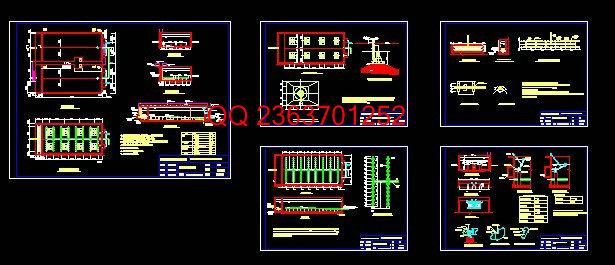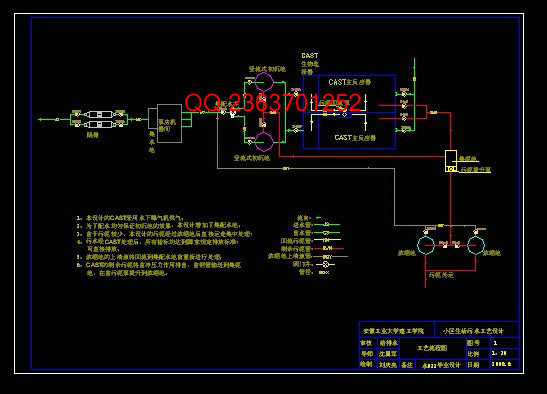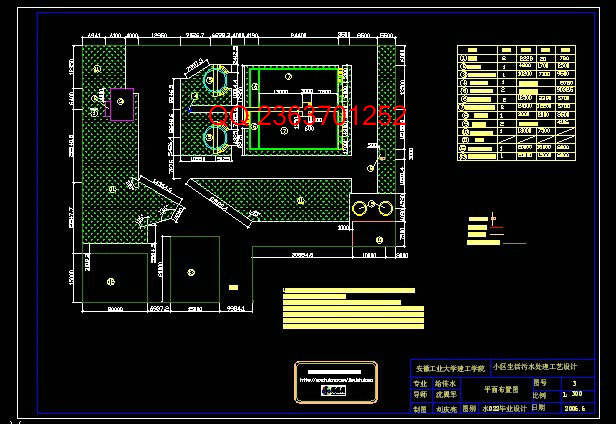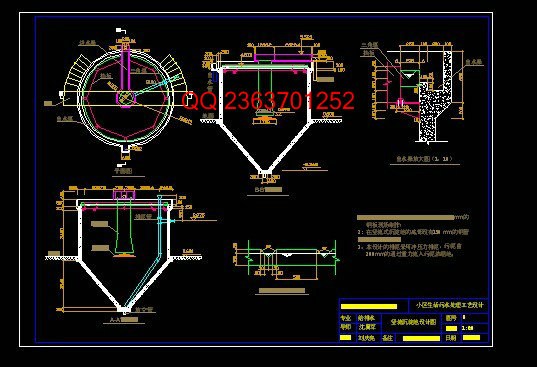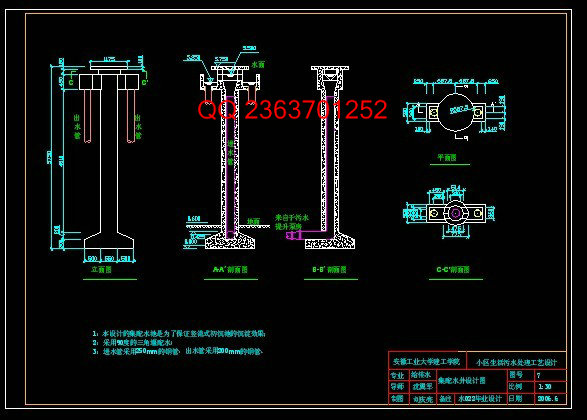|
设计简介 |
设计描述:
文档包括:
WORD版设计说明书1份,共62页,约28000字
CAD版本图纸,共12张
摘要
小区生活污水的处理近年来越来越受到重视。小区污水的特点是可生化性好,适合采用生物处理的方法如:活性污泥法、生物膜法等。CAST有很多的优点,例如CAST工艺运行稳定,对有机物的去除效果好,抗冲击负荷能力强,产泥量小,不发生污泥膨胀,反应推动力大,能在低温环境中长期运行,并保持高的处理效率。与其他二级处理相比CAST工艺投资少、运行费用低、管理方便。
根据设计任务,本设计选用CAST做为小区生活污水的处理工艺,具有投资少,运行费用低,自动化程度高,噪音小的特点,并且处理水质能达到国家规定的排放标准。本设计说明书重点说明了CAST工艺在处理小区生活污水时所采用的运行参数、设计的计算方法和过程,以及一些常用水处理构筑物的设计计算方法,通过设计能达到预期的处理效果。
关键词
小区生活污水 活性污泥法 CAST 负荷
ABSTRACT
The processing of the wastewater of biotope is subjected to value more and more in recent years. The characteristic of biotope wastewater is good for bio-chemical. Adoption the biological treatment, such as: the activated sludge processing, the slime process etc. The Cyclic activated sludge technology has many advantages, for example: Cyclic activated sludge technology can work steadily and removal organic matter effectly, Cyclic activated sludge technology has excellent ability of bearing high impact loads, the amount of sludge is small, no sludge swell, the reaction impulses is larger, Cyclic activated sludge technology also can work at low temperatures, and keep high rate to removal. Comparing with the secondary treatment process, the costs of construction and operation of Cyclic activated sludge technology is much lower,operation is simply.
According to design mission ,this design chooses Cyclic activated sludge technology to treatment the wastewater of biotope, low investment, low expenses of operation, automate degree high, noise small, and the quality of effluent can attain the nation standard. The emphasis of this design is explained Cyclic activated sludge technology’s the operation parameter, calculation method and process of design while treat the wastewater of biotope, and some calculation method of design of construct in common wastewater treatment processing, the design of the Cyclic activated sludge technology can attain expectation of processing result.
KEYWORDS
Biotope wastewater, activated sludge processing, Cyclic activated sludge technology, load
目录
摘要 i
ABSTRACT ii
前言 1
1. 文献综述 2
1.1. 现阶段我国水资源状况 2
1.2. 小区生活污水的定义来源及特征 2
1.2.1. 定义 2
1.2.2. 来源 2
1.2.3. 特征 2
1.3. 现阶段国内外生活污水处理工艺 3
1.3.1. A/O工艺 3
1.3.2. A/B工艺 3
1.3.3. SBR工艺 4
1.3.4. 氧化沟工艺 9
1.3.5. 生物膜 11
1.3.6. 厌氧工艺 13
2. 小区生活处理工艺方案 14
2.1. 处理要求 14
2.1.1. 水质情况 14
2.1.2. 处理程度计算 14
2.2. 小区生活污水处理的原则 15
2.3. 小区生活污水处理应注意的问题 15
2.4. 生活污水处理的典型工艺流程 15
2.5. 确定方案 16
2.5.1. 确定工艺流程 16
2.5.2. 提出方案 18
2.5.3. 方案比较 19
2.5.4. 工艺比较结果 21
3. 工艺设计计算 22
3.1. 泵前粗格栅 22
3.1.1. 设计参数 22
3.1.2. 计算 22
3.2. 污水提升泵房设计计算 23
3.2.1. 集水间的设计 24
3.2.2. 泵房机器间设计计算 25
3.3. 集配水井设计计算 28
3.4. 初沉设计计算 29
3.5. CAST主反应池的设计计算 34
3.5.1. 采用间断进水设计的原因 34
3.5.2. 采用泥龄法设计的原因 34
3.5.3. CAST计算 35
3.6. 浓缩池的设计计算 46
3.6.1. 浓缩污泥量的计算 46
3.6.2. 间歇式浓缩池设计计算 48
3.7. 高程计算 51
3.7.1. 污水部分水头损失计算 51
3.7.2. 污泥部分水头损失计算 51
4. 概预算 52
4.1. 编制依据 52
4.2. 工程投资概算 52
4.2.1. 直接费用 52
4.2.2. 间接费用 54
4.3. 直接运营费用 54
总结 55
致谢 56
参考文献 57
附录 58
|





